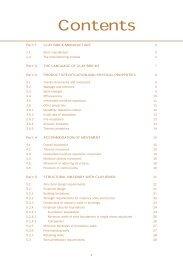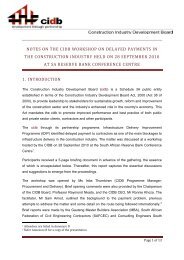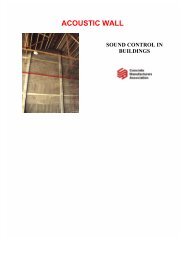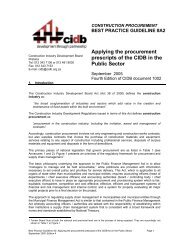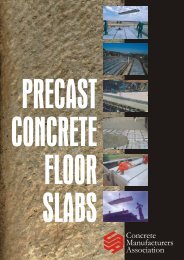MANUAL 4 - Construction Industry Development Board
MANUAL 4 - Construction Industry Development Board
MANUAL 4 - Construction Industry Development Board
You also want an ePaper? Increase the reach of your titles
YUMPU automatically turns print PDFs into web optimized ePapers that Google loves.
MODULE<br />
1<br />
2<br />
3<br />
4<br />
5<br />
6<br />
7<br />
<strong>MANUAL</strong> 4 – BITUMINOUS PAVEMENT SEALS<br />
5.3.3 Prime coat<br />
It is claimed that Otta seals do not require primed surfaces on which they are to be<br />
constructed (except in the case of calcareous material).<br />
On labour-intensive projects, where the work proceeds relatively slowly and the constructed<br />
base may be opened to traffic for extended periods, it is recommended that the base be<br />
primed, using an inverted emulsion prime at the maximum rate of 0,7 litres/m 2 , depending<br />
on porosity/absorption of the base.<br />
The prime can be applied with the motorised hand sprayer as the work proceeds and so<br />
protect the base or open the base to light traffic.<br />
If the base is an ETB, a diluted emulsion can be used instead of the inverted prime.<br />
5.4 Use of pan and cylinder to determine aggregate application rate for<br />
Otta seal<br />
5.4.1 General<br />
The pan and cylinder method is a quick manner of determining the ALD (average least<br />
dimension) of the aggregate, i.e. by placing the aggregate in the pan, shoulder to shoulder,<br />
pouring this quantity of aggregate into the cylinder using a graduated scale measuring the<br />
depth of aggregate in the cylinder. (Figure 4.18)<br />
This depth of aggregate equates to the ALD of the stone and, if divided by 1 000, gives the<br />
rate of application in m 3 /m 2 required for the aggregate.<br />
This procedure is applicable for normal seals for determining the ALDs.<br />
5.4.2 Use for Otta seal<br />
The pan and cylinder is eminently suitable for determining the rate of application of the<br />
aggregate for Otta seals as follows:<br />
• Fill the pan with the approved graded stone to a depth required in the field, e.g.<br />
16 mm or 19 mm and how it should look after application – before rolling.<br />
• Pour the contents in the pan into the cylinder, carefully without spilling any of the<br />
aggregate.<br />
• Drop the cylinder three or four times from a height of 50 mm onto a firm surface to<br />
settle the contents. Level off the top of the surface on which you place the graduated<br />
scale.<br />
• Read off the remaining height on the graduated scale and this reading will give the<br />
theoretical ALD/or thickness of the layer as placed in the pan and required in the field,<br />
e.g. 20,6 mm.<br />
• By dividing this reading on the graduated scale by 1 000, the rate of application in<br />
m 3 /m 2 is established.<br />
e.g. 20,6 mm 3 1 m 3 1 m = 0,0206 m 3 /m 2<br />
1 000<br />
• From this required rate of application, the spotting distances can be calculated for the<br />
known half width of the road.<br />
IMPLEMENTING EMPLOYMENT INTENSIVE ROAD WORKS 88





